Showing 29 - 38 of 39 posts found matching keyword: science
Friday 10 October 2008
Today was supposed to be the end of the world. So if you're reading this, we must all be dead.

A lot of furor was made this summer over the activation of the Large Hadron Collider (LHC) in Switzerland. The LHC is a $6 billion chemistry set designed to replicate the natural collision between sub-atomic particles at near the speed of light in order to substantiate the existence of theoretical particles of matter. Try doing that in your garage!
However, some grizzled curmudgeons have complained that the replication of the natural collision of particles could result in black holes that will rend the Earth atwain! But who ever listens to the town drunk who warns us not to go down to the lake? At least these complainers are smart enough not to make the more logical complaint that Switzerland has built something the size of a city to explore a purely academic scientific pursuit instead of throwing that $6 billion at something more practical, such as clean coal, hydrogen fuel cells, or growing hamburgers on trees. It's the more sensational fear of the apocalypse that grabs headlines, not simple whining about political boondoggles.
This morning, it turns out that sucking sound you hear is really just the implosion of the U.S. economy. Fortunately for all of mankind, the LHC sprung a leak (meaning that it could no longer contain those black-hole spawning particles) and was shut down last month, long before it could reach the tests scheduled for today that would end the world. Those Earth-destroying tests have been rescheduled for next year.
I don't know about the rest of you, but I for one am pleased that we have several more months until an artificial black hole births a rampaging energy being that threatens to destroy the Earth, as depicted in the Sci-Fi Channel documentary The Black Hole. Even though scientist Judd Nelson will no doubt arrive to save the day, I'm already constructing a rocket ship to blast my newborn son to a distant planet where, in comparison to the primitive men that populate that planet and aided by the world's white sun, he will have powers and abilities far beyond those of mortal men.
Comments (0) | Leave a Comment | Tags: economy lhc movies science
Tuesday 7 October 2008
The same day I discovered how much spam I was receiving (see previous post for details), I watched the 1973 Michael Crichton-written film Westworld in which the attractions in a lavish theme park inexplicably become murderous. (Really, it's exactly the same movie as the 1993 Michael Crichton-written film Jurassic Park but with less explanation for why the attractions are killing people.) Perhaps it's because I had already been looking at numbers that afternoon, but I became captivated by the economics of Westworld.
The park guests attending the theme park Delos (of which Westworld is just one part, like Frontierland or Adventureland at Walt Disney World Resort) each pay $1,000 per day for a week-long visit to the theme park of their imagination. So for a mere $7,000, these guests spend a week surrounded mostly by robots who simulate the lifestyles, behaviors, and mores of inhabitants of the mythical American West. While that may seem expensive for simple park admission, think about it this way: for $7,000 they get to abuse, kill, or sexually molest machines, who for all practical purposes, are human beings. Says one fellow in a promotional video at the beginning of the movie, "I shot six people!" When you look at it that way, the price of admission becomes a bargain when you consider that the costs of the same actions outside of theme parks is likely life in prison or worse.
It's worth noting here that the Grecian island of Delos was once sacred to the ancient Athenian civilization. Besides being the birthplace of Apollo and Artemis -- god and goddess of arts and the hunt, respectively -- Delos was also famed as a location upon which people were forbidden to be born or die. Quite fitting for a theme park populated by robots. And a way better name than Six Flags.
But more to the point, there are approximately 20 guests seen delivered to Delos by hovercraft for their weekly stay. (Apparently, even in 1973, monorails were artifacts. And to be fair, an actual count appears to be 18 people, but I'm rounding up, figuring in Delos' favor that this was an off-week as they appear to have a slightly greater capacity than they are using.) That means that the gross weekly income at Delos was $140,000, or over $7 million per year generated by 1040 guests, assuming there is no "off" season.
Delos is a very large enterprise, consisting of three "worlds," each populated by dozens of unique and technologically-advanced robots, period-accurate buildings and an underground central command and control complex coordinating the entire site's operations. Weekly expenditures for power and maintenance of such amazing facilities and mechanical marvels would have to be staggering, well exceeding $140,000! (Walt Disney World doesn't release operating costs, but they recently bragged that an energy overhaul saved them 100 million kilowatt hours of electricity per year. At the average Florida commercial price of 10 cents per kwh, that's a monthly savings of well over $800,000!)
To compare, Walt Disney World, opened in 1971, is a huge operation maintained not by expensive robots but by teenagers dressed as "cast members." Well more than 10 millions visitors pass through the Walt Disney World gates every year, 10,000 times greater attendance than Delos achieves! A well-to-do modern day visitor to Walt Disney World could pay well over $5,000 for park admission, room, and food for a week, all of which are included in the admission price to Delos. Transform that $5,000 in modern cash to 1973 dollars, and you find that it's roughly equivalent to... $1,000. Just think about how much red ink there must be on Delos' books!
While having your rides assassinate all of your guests and staff is certainly bad for business, it's probably a better option than actually letting your guests shoot holes in your rides. I'm certainly no business major, but I'm pretty sure that Business 101 includes the maxim that if you construct one-of-a-kind replicas of famed Western actor Yul Brenner, don't let your customers destroy them for a mere $1,000 a day. After all, also in 1973, the United States Government spent six million dollars upgrading just one man! And that was only 2 legs and an arm!
Comments (0) | Leave a Comment | Tags: disney economy history movies science westworld
Saturday 2 August 2008
NASA has recently announced that they finally have definitive proof of water on Mars. (It melts at 0° Celsius, releasing twice as much hydrogen as oxygen. And added to noodles, it makes a mean soup. It must be water!) Though finding water isn't exactly the same as finding life, this is an indication that life may be much more common throughout the universe than previously assumed.
Despite this assurance that "we are (probably) not alone," America's general reaction to this news seems to be a collective, "so what?" I keep hearing the repeated complaints that our endeavors should be limited to correcting the social and economic inequalities on Earth rather than waste time looking to the stars. At first, I found this lack of curiosity appalling until I realized that they have a point: since the root cause of humanity's problems are generated by the greed and insecurities of humanity, should we really be excited about discovering more like us among the heavens?
Would we be comforted to discover a distant planet of humanoid creatures who had learned to tap into their own minds for power, allowing them to create a civilization free from physical limitations? Only, that civilization, like ours, had failed to account for its own subconscious self-destructive tendencies, and their newfound powers led directly to the unintentional division and destruction of their own race?
Wait, wait. That was the story of Forbidden Planet, wasn't it? Sorry. I must still be a little worked up over the whole Keanu/Klaatu thing from the other day. I'll try to contain myself in the future.
Comments (0) | Leave a Comment | Tags: movies news science space
Monday 21 April 2008
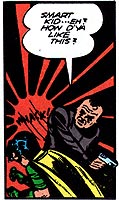 Batman and Robin are frequently hit over the head hard enough to incapacitate them, an act that has likely happened to them at least 4 times a year (conservative estimate? -- it happened a lot more back in the day than it does now) since the pair first formed in 1940. That's something like 272 blows to the head each. Since "a blow to the head that leaves you dazed or unconscious" is the very definition of concussion, it's safe to say that the Dynamic Duo spend a lot of time concussed. Most of those knocks to the noggin were no doubt to the back of the head (who ever knocks Batman for a loop when he sees it coming?), the area of the head from which the worst concussion damage results. Multiple concussions have been proven to lead to an increased risk of developing epilepsy and Alzheimer's Disease. So why aren't Batman and Robin spastic amnesiacs yet?
Batman and Robin are frequently hit over the head hard enough to incapacitate them, an act that has likely happened to them at least 4 times a year (conservative estimate? -- it happened a lot more back in the day than it does now) since the pair first formed in 1940. That's something like 272 blows to the head each. Since "a blow to the head that leaves you dazed or unconscious" is the very definition of concussion, it's safe to say that the Dynamic Duo spend a lot of time concussed. Most of those knocks to the noggin were no doubt to the back of the head (who ever knocks Batman for a loop when he sees it coming?), the area of the head from which the worst concussion damage results. Multiple concussions have been proven to lead to an increased risk of developing epilepsy and Alzheimer's Disease. So why aren't Batman and Robin spastic amnesiacs yet?
The Mayo Clinic recommends several helpful tips for preventing concussions, including wearing helmets, "fallproof"-ing your home, and wearing sensible shoes. Better safe than sorry, boys.
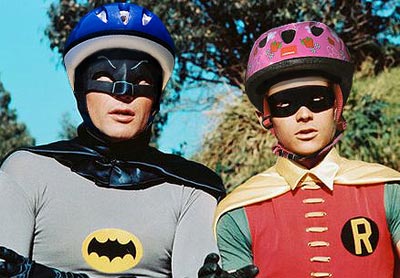
Comments (0) | Leave a Comment | Tags: batman comic books science
Wednesday 19 March 2008
Remember last month when I mentioned that I consumed a considerable amount of Coca-Cola? Well, I don't. (I don't remember it, that is. I still do drink a lot of Coke.)
Perusing the latest Reader's Digest, I was stunned to learn that a researcher for the University of Alabama at Birmingham has completed studies that indicate that excessive consumption of sugary soda beverages may lead to the development of Alzheimer's Disease later in life. Uh-oh. Of course, this caused me to panic.
A couple of minutes later when I had forgotten why I was panicking, I looked more deeply into the details of this study on my friend The Internet. Surprisingly, Reader's Digest had given me only part of the story. (Who would have guessed?) I discovered that the studied mice were from stock bred to develop Alzheimer's-like symptoms, and the announcement was made based on the soda-swilling meese's slightly increased "brain plaque" deposits, which may be an Alzheimer's indicator. But what really settled me down was that it turns out that this frightening study used only 8 mice in the control group and 7 mice in the experiment for a grand total of 15 mice in all! Talk about your small sample size. That's like finding a single test audience that enjoyed Catwoman before advertising the movie as a "Summer Blockbuster!"
On a semi-related note, is it just me, or are Reader's Digest "It Pays To Enrich Your Word Power" vocabulary words getting easier?
Comments (0) | Leave a Comment | Tags: coke internet science
Thursday 31 May 2007
Scientists have discovered that female cheetahs mate with many males instead of one. I suppose that means that female cheetahs are fast.
Comments (0) | Leave a Comment | Tags: puns science sex
Tuesday 24 April 2007
The Natural History Museum in London has announced the discovery of kryptonite deep in a mine in Jadar, Serbia. In the words of British geologist Dr. Chris Stanley, "the new mineral does not contain fluorine [which the green Kryptonite in Superman Returns contains] and is white rather than green, but in all other respects the chemistry matches that for the rock containing kryptonite. We will have to be careful with it -- we wouldn't want to deprive Earth of its most famous superhero!" Dr. Stanley may have more to worry about than just the life of Superman. That rock could result in the destruction of Earth as we know it.
Most people are aware of the existence of green Kryptonite, the one thing that can hurt the Man of Steel. But just as dangerous are the other colorful fragments of the planet Krypton, including the little-known white Kryptonite!
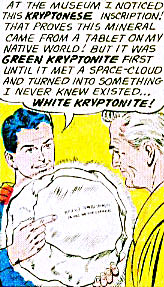
That's right, what those miners in Serbia have unleashed could be the doom of us all. And they should have known better. Has anyone ever seen a movie in which something great was found buried deep in the Earth? No, you haven't, because nothing good has ever been found buried deep within the Earth. As we all know, the Earth only contains hibernating aliens (The Thing, Quatermass and the Pit), overgrown lizards (Journey to the Center of the Earth, Rodan), disfigured mutants (The Time Machine, C.H.U.D.), murder-inducing stones and metals (Blood Diamond, Goldfinger), and scene-stealing lava flows (Volcano, Dante's Peak), none of which are very benevolent.
How could this Serbian white Kryptonite hurt us? I'll let an expert in Kryptonite explain:
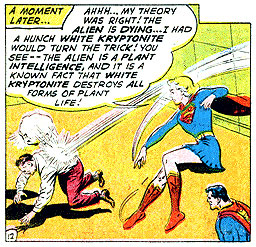
"All forms of plant life!" Someone needs to tell Al Gore that a bigger threat to the world's biosphere than global warming has been unearthed on the European continent. Everything from the towering redwood trees to the ocean's plentiful plankton are now endangered by the Serbian chalky white Kryptonite. Without the food-chain's essential link, Oxygen-producing plant life, how long could humanity hold on? Could the extinction of the entire world's population be the last laugh of the recently deceased genocidal Serbian leader Slobodan Milosovic?
Only time will tell if we will survive this latest threat from beneath the Earth's crust. You'd best be careful with your new mineral, Dr. Stanley. The whole world is counting on you.
Comments (0) | Leave a Comment | Tags: comic books kryptonite science superman
Wednesday 18 October 2006
I have a friend who is absolutely in love with Oscar Goldman, the eternally inappropriately sunglassed chief of the U.S. government's Office of Scientific Intelligence (OSI) and boss of United States Air Force Colonel Steve Austin, the world's only Six Million Dollar Man. Because of this man-crush, I'm frequently subjected to long marathons of Six Million Dollar Man episodes, one of the most boring shows known to mankind. As an unwilling participant in the misadventures of Steve Austin, I've learned quite a few things about how poorly the United States handles its scientific secrets and how world-famous NASA moon astronauts spend their free time.
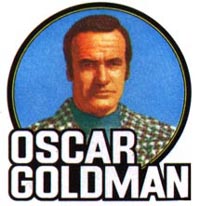
For those of you who may not know, Col. Austin was chosen for bionic implants after he crashed a NASA test plane. Sure, we may have the technology, and technically we can rebuild him, but why would we want to? It's an expensive procedure to waste on a fellow who can't even properly land a plane. (By the way, $6,000,000 - six million with an "M" - in 1973 translates into nearly $30,000,000,000 - thirty billion with a "B" - in 2006 when adjusted for inflation using NASA's own inflation calculator. That's approximately how much money the world's second richest man, Warren Buffet, recently gave the world's richest man, Bill Gates, to spend on eradicating pandemic diseases. I suppose that no one told him that he could have purchased bionic limbs for the same cost.)
Presumably, Austin's particular disfigurement was perfectly compatible with the potential bionic replacement surgery that the OSI had already planned for a future accident victim, but I'm really not sure why they chose Steve Austin. Austin is demonstrated, even in the pilot episode, to be a laid-back, sunrise-watching, skirt-chasing, self-indulgent pacifist. Hardly a prime candidate for the job of "patriotic super-spy." In fact, Austin will even lament the implementation of his bionics, calling himself "less than human." Steve, last time I checked, being faster than a speeding bullet and more powerful than a locomotive does not lower you to "less-than-human" status; laying in bed and complaining about how good you now have it does.
The good Col. Austin had both of his legs replaced with bionic limbs that could propel him at speeds up to 60 miles per hour. His new bionic right arm could lift several hundred pounds effortlessly. His destroyed left eye was replaced with a camera that could provide a 20x magnification. And all of these modifications were made without reinforcing his hips for the jostling of the extreme vibrations while running, his spine from the torque created while lifting cars, or his skull from the frequent "karate chop" knockout blows to the head that every thug, hitman, and Soviet spy would employ to incapacitate him. That's good medicine.

Most disturbing (and far-fetched) is the premise that these bionic enhancements are powered by self-contained atomic generators in the arm and legs. That alone should be a far more spectacular accomplishment than the bionics these generators power, but it is frequently played down during the shows. In a typical nuclear reactor, radioactive decay is harnessed to heat water for energy generating steam-powered turbines. This makes Steve either radioactive or full of hot air, maybe both. It's possible that since you never saw Steve water his legs, his generators were a new kind of atomic power unfit for anything other than making metal legs move really fast. In fact, I don't recall anything else during the run of the show using the power of these generators in any other way. Nuclear power was instead frequently shown to be a dangerous tool demonstrated by way of several near reactor meltdowns, missing atomic devices, and the destruction of the Bahamas via a nuclear warhead (detonated by Steve himself). Were we supposed to be subtly fooled into believing that Col. Austin was extra-dangerous because of his nuclear powered limbs?
Once fully healed, Steve Austin was put to work as a super spy in order to pay the government back for his new Top Secret "Security Clearance Level 5" super powers. (On a USAF Colonel's O-6 salary, which I estimate was probably slightly less than $20,000 in 1973, including his NASA and super spy bonuses, paying back those $6,000,000 would probably have taken a mere 600 years.) He refused the job at first and has to be tricked into dueling with the Russians for the location of a stolen American warhead. (I know it doesn't sound like something that someone can be tricked into, but Col. Austin does not list "Mensa Membership" anywhere on his bizarre resume.) Reluctantly, Steve agrees to be OSI's poodle, and soon found himself battling Russians, foreign terrorists, mobsters, assassins, robots, moonshiners, rogue archeologists, other bionic men, crooked cops, rockstar groupies, imposter Steve Austins, telepaths, mountain lions, earthquakes, aliens, sharks, and John Saxon.
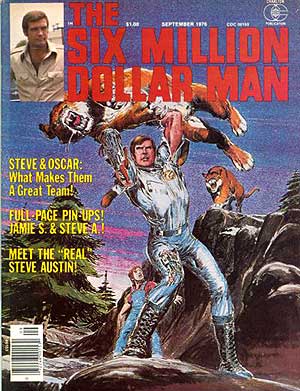
As a secret agent, Steve reflected James Bond's frequent misunderstanding of stealth and low profiles. Col. Steve Austin, astronaut and college football star quarterback, was widely recognized throughout the world, destroying most chances for subtlety. I suppose that super speed and strength don't naturally lend themselves to guileful subterfuge, but then neither did Steve's fashion sense. (Button up that shirt, Steve!)
What little camouflage Steve did possess was often lost when Steve would capriciously reveal his enhancements to anyone within earshot. He simply couldn't resist the opportunity to jump over a 10-feet tall fence or race an automobile. Steve, here's a super-spy tip: using the line "I eat a lot of carrots," to explain away how you were able to read a car's licence plate several hundred yards away in the dark isn't going to stand up to any real scrutiny. Steve's indiscretion became so widespread, even Monday Night Football host Frank Gifford who supposedly played college ball against Steve Austin in the early 1950s was therefore naturally entrusted with knowledge of Steve's top secret enhancements. (Guest stars always found out about Steve's abilities. William Shatner, Farah Fawcett, and Gary Collins among others all were entrusted with some of the nation's most classified information. They were a trustworthy bunch, I'm sure.)
So Steve Austin was a lousy pilot and an incompetent spy. Based on the fact that the only female interest that he could keep was a fellow American bionic slave/spy, I'm guessing he was probably a poor lover, as well. In one episode, Steve even admits to a crippled boy that he fumbled a lot as a football player. It should be no surprise that Oscar sends Steve to the ends of the earth (which generally looked suspiciously like southern California) on pointless suicide missions; he has to be hoping that one day, Steve won't come back. I sure do.
Comments (0) | Leave a Comment | Tags: friends oscar goldman otto science six million dollar man television
Tuesday 10 October 2006
Look, up in the sky! It's a bird! It's a plane! It's the Sun!
I think that if I were a religious person, I'd probably worship the Sun. Sure, the Sun provides the light energy that makes life possible on Earth, and it has been worshipped by humans for as long as we've been standing upright. Links between the Sun and Christianity (the religion of the "Son") are as well established as the date for Christmas. (Interestingly, the name of the Islamic god, "Allah," may have been derived for a pagan Arabic god of the Moon, the anti-Sun. But that's not today's point.) Despite all of this, the Sun's unique relationship to modern culture goes largely ignored. The Sun gave us superheroes.
The archetype of the modern costumed hero, Superman is powered directly by the Sun. The rays of the Earth's yellow sun charge Superman's amazing Kryptonian physique, allowing him the powers of flight, super sense, and invulnerability. Without the Sun, there's no Man of Steel. That makes the Sun directly responsible for Earth's greatest champion.
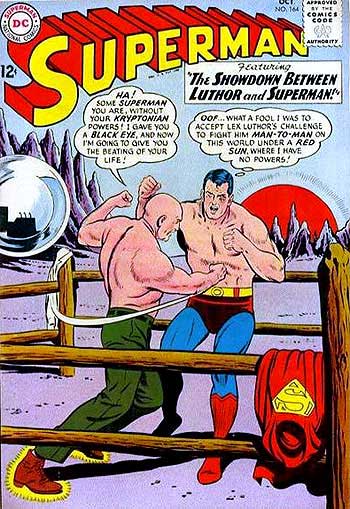
The anti-Superman, Batman, is also controlled by the Sun. Unlike Superman, Bruce Wayne has no alien physiology, and must limit his crime-fighting to survivable situations. He chose to adopt a demonic costume and fight in the dark, knowing that his training, combined with mankind's inherent fear of the unknown ("Things That Go Bump in the Dark") will give him an edge against the criminal element. The fictitious construct that is "The Batman" could not function in daylight, and only inspires fear in situations where the Sun is absent. (You can't have a Dark Knight without the dark night.) Again, the abilities and character of one of the archetypical heroes of modern culture, The Batman, is determined directly by the Sun.
As if those two weren't great enough examples of the Sun's influence on American popular culture in general and the superhero in specific, the modern archetype for the superheroic family/team, the Fantastic Four, gained their powers from Cosmic Rays, which by their very nature are generated by the Sun. The Sun's natural radiation must also be responsible for some of the X-Men's bizarre super-human mutations, such as those possessed by Sunspot and Dazzler.
If the Sun has provided all of these powerful and admirable superheroes with their reason for being, I can't think of anything better to devote to worshiping. It certainly makes more sense than Catholicism.
Comments (0) | Leave a Comment | Tags: batman comic books religion science superman
Friday 25 August 2006
Pluto is not a planet. So sayeth the International Astronomical Union. ("International Astronomical"? Are they inclusive enough with their title? "Can everybody find a seat?")
As of yesterday, the World Scientists, in a very 1984 scenario, voted to re-define the term "planet." Because of the new definition, Pluto got the cold shoulder. Feeling sorry for the old bean, they created a new category of "dwarf planet" for Pluto and it's solar-system neighbors. I think most people will agree that the tag "dwarf" is not much of a consolation prize.
I'm not really against this decision. Pluto has never quite gotten along with the gang. (Think of the dweeb that used to hang around with your clique in high school just so that you & your friends would have someone to stuff into trashcans: that's Pluto to the other planets.) I suppose it's more surprising that it took scientists several thousand years to define the word "planet," a word with a vestigial tail lingering from ancient Greek and a concept strongly tied to ancient pagan polytheistic deity worship. Confusion of the nature of planets has lingered for years; in the past, even large asteroids have been considered planets, if only temporarily. It's nice to finally have some closure on the issue, at least for a few hundred years or so, when they'll no doubt redefine it again.
On the other hand, this redefinition of Pluto may have long lasting and drastic implications on modern culture. Disney will have to put down Mickey's dog. Whole planetariums will have to be razed and rebuilt from scratch. On my Solarquest game board, Pluto property values will plummet. Galactus, the Eater of Planets, will have to tighten his belt. Millions of textbooks will have to have stickers added that say, "See? Scientists are fickle and can't decide on anything so evolution must be bullshit." The last four generations of humans will begin to question everything that they've ever been taught by The Man. (Wisely, the prescient Gustav Holst refused to compose an amended Pluto movement for his masterpiece suite The Planets, saving his artistic legacy from scientific destruction.) In short, this nearsighted redefinition has the potential to DESTROY THE WORLD.
And then again, when was the last time that you really thought about Pluto, anyway? Maybe this is just a PR move on the part of a washed-up attention-hound long discarded. Perhaps Pluto, which could really never make up its mind if it was the 8th or 9th planet, simply decided it was time for a new crowd and finally moved out of it's parents' basement. Good for you, Pluto! Go be somebody! This is the 21st century; if a dwarf can't make it here, there's always next century.
Comments (0) | Leave a Comment | Tags: pluto rant science space

